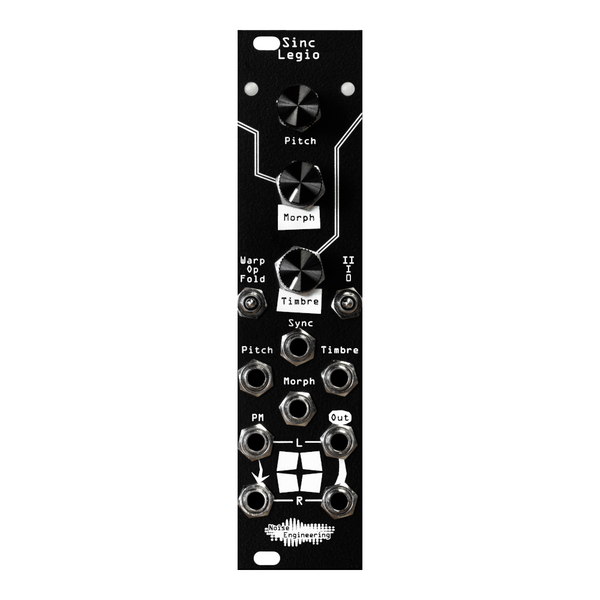Introducing Sinc Legio
Last Thursday, we announced Sinc Legio, the newest addition to our Legio oscillator/FX platform. Sinc Legio started with a desire to create a utilitarian oscillator, and, unsurprisingly, ended up going far beyond the timbres we’d initially conceptualized.
Today, we’ll chat about its features, the history of the module, and listen to some fun jams.

Algorithms and operators
Similar to the first Legio firmware, Virt Iter Legio, Sinc Legio is a stereo oscillator with a vintage-inspired chorus and independent left/right phase-modulation inputs. If you’ve used Virt, the layout and controls will feel very similar, but the sound of Sinc Legio is entirely different.
If you need some basic waveforms, Fold mode is a great starting point: Morph continuously fades between different waves, and Timbre adds wavefolding to them (because wavefolders are awesome). Fold mode was the core design of the original Sinc Legio concept, too: simple waveforms, a folder to brighten things up, and a chorus to make things wide when you need some stereo. It’s a great tool for more traditional analog-inspired patches, and it sounds fantastic.
The other two algorithms are based around phase modulation. Phase modulation sounds quite similar to FM, and is an easy way to create complex and metallic timbres. Op mode is a simple two-operator PM patch, where Timbre controls the amount of phase modulation applied to the carrier oscillator, and also the amount of external PM applied to the modulating oscillator. Since Timbre can be voltage controlled, this is a great way to simplify complex patches: controlling FM modulation amounts, especially in stereo, usually requires multiple VCAs in series, and this algorithm simplifies it into a small package.
Warp mode uses a phase modulation algorithm where the modulator is mixed in with the carrier. This is an unusual signal flow, and sounds quite different to Op mode and, in fact, most other FM or PM synths. Warp can be dissonant and atonal, or warm and buzzy: dial in the perfect sound to match your patch.
Sinc and Sinc: a retrospective
A long time ago we released an oscillator called Sinc Iter. It was a tiny, utilitarian oscillator with some unusual features (if you need to make music that only bats or elephants can hear, it’s a good choice). It’s been long discontinued, but we still liked some of its core concepts, and we decided we wanted to have a similarly straightforward oscillator in our lineup.
At this year’s annual planning meeting, Synthdaddi, the idea of a “simple” oscillator was proposed (with the understanding that, let’s be real, we’ll probably never make a simple or traditional module around here). We planned to put it onto the Legio platform, and used Sinc Iter as a starting point: phase modulation, hard sync, and wavemorphing were all features we wanted to bring to our new oscillator platform.
That’s where the similarities between the new and the old Sinc ended, though. In a flurry of rapid development the week after we returned home, we threw everything but the kitchen sink at Sinc Legio and ended up finalizing the firmware three days later. Those three days were full of fun, fear, and phase modulation*, but in the end we were quite happy with the sounds we got out of Sinc Legio. And hey, it can do simple if you want it to!
*I had to check but that still counts as alliteration.
Try Sinc Legio today
Sinc Legio, as usual, is currently available as a paneled module from our webshop and your favorite retailers, or as an alternate firmware from the Customer Portal if you already own a Legio. Speaking of firmware swapping, some of our friends have already had a playthrough with Sinc Legio: Jeremy aka Red Means Recording recorded this absolutely stellar jam using Sinc Legio as the main melodic sound source.





